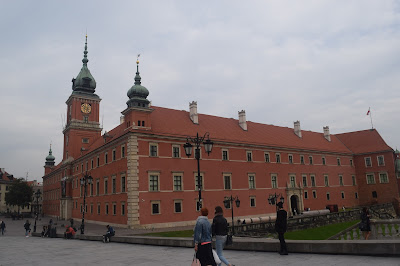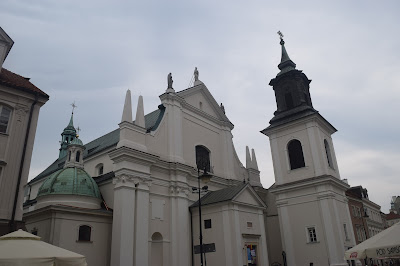Warsaw, Poland: The Odyssean Past Part 2
The
Polish capital today is like a sculpture carved and polished through time and
experience. The modern metropolis today provides a glimpse of the rich history
of Poland and the Polish nation. From the period of monarchy, to the partition and
dissolution of Poland, the reestablishment and independence of the Republic of
Poland, to the occupation of the Nazi Germany, to the liberation in the Second
World War, to being under the influence of the Soviet Union during the Cold
War, Warsaw the Polish capital is a reminder of the progress that has been done
to make Poland one of the most progressive country in Eastern Europe today.
This has caught my interest as a visiting tourist in Warsaw. This is the second
part. Click here for the first part.
1.
Teatr Maskarada dla dzieci
The Masquerade Theatre exhibits performances for school chuldren and
presschool with the use of visual presentations, choreography and puppets.
2.
Plac Zamkowy
The Castle Square is located in front of the former residence of the
Polish monarchs. This is also the venue
of dramatic scenes in Polish history from the 18th century to the
modern times.
3.
Zamek Królewski w Warszawie
The Royal Castle is the former residence of the Polish monarchs until the
several periods of partitions of Poland. After Poland has gained independence,
it served as the residence of the Polish president until during the occupation
of Nazi Germany when the German Governor-General resided here. The palace was
destroyed during the Second World War.
4.
Kolumna Zygmunta III Wazy
Sigismund’s Column was built in commemoration of the Polish King, who
moved the Polish capital from Krakow to Warsaw. During the Warsaw uprising
against the invading Nazi-Germans, the statue was demolished by the latter.
5.
Grodzka
This is a street leading to the Castle Square. It was named after a
Polish politician, who was the first openly transgender member of the Polish
Parliament.
6.
Kościół Akademicki św. Anny
St. Anne’s Church is one of the oldest buildings in Warsaw. It is the
main church parish of the academic community in the Polish capital.
7.
Kanonia
This square was an area of the former church cemetery. It is located at
the back of the Cathedral of John in Warsaw.
8.
Bazylika Archikatedralna w Warszawie pw
This is the cathedral of the archdiocese of Warsaw and one of the
oldest churches in the capital. It is one of the most important places of
Polish culture and tradition. It was almost completely destroyed during the
German occupation.
9.
Rynek Starego Miasta
The Old Town Market Place is the heart of the Old Town and one of the
most popular tourist destination in Warsaw. It was systematically destroyed by
the German Army during its occupation before it was rebuilt after the Second
World War.
10.
Barbakan Warsawski
This is a semi-circular fortified post between the Old Town and the New
Town. It was supposed to protect the Old Town from any invasion or any threats
before.
11.
Kościół Paulinów Św. Ducha i św. Pawła
The Pauline Church of the Holy Spirit is located in the New Town. The first
church was built of wood with a hospital nearby. It witnessed the Swedish
invasion during the Northern Wars.
12.
Kościól Dominikanów pw. św. Jacka
This Baroque church was built in the 16th century. During the cholera
epidemic, the Dominican church and monastery of Sts. Jack was deserted.
13.
Kościół Sakramentek pw. św. Kazimierza
St. Kazimierz Church is a Roman Catholic church in the New Town. It was
used before as the residence of the court, and was later purchased by the
Polish queen to be transformed into a church.
14.
Rynek Nowego Miasta
The New Town Market Square was built in the 14th century. It was burned
down by the Swedes before it was rebuilt thereafter. It was destroyed and
rebuilt again during and after the Second World War.
15.
Kościół św. Benona
The Church of Sts. Benon was a church of the Redemptorists, who were
accused of favoring Austria and the French authorities before they have been
expelled from Warsaw. It was transformed into barracks, then school, military
storage, house and factory before it was rebuilt as a church again after the
Second World War.
16.
Kościół Nawiedzenia Najświętszej Marii
The Church of the Visitation of the Blessed Virgin Mary is located in
the New Town. It was the site of a pagan temple in the 14th century
before a Gothic church was built on the site. It stands on the banks of the
Vistula River, running along the Polish capital.
17.
Veturilo Kościelna
Veturilo is a recreational area along the banks of Vistula River. It
connects the New Town Market Place to the fountain park.
18.
Multimedialny Park Fontann
The Multimedia Fountain Park is a complex of four fountains located
within a 12-hectare park. The fountain commemorates the 125th
anniversary of the Municipal Water and Sewage.
19.
Skwer 1 Dywizji Pancernej WP
Square 1 Armoured Division of the Polish Army is the park surrounding
the Multimedia Park Fountain located in the New Town of Warsaw.
20.
Kościół Franciszkanów, Stygmatów św
The Church of St. Francis of Assisi is an Franciscan Roman Catholic
church located in the New Town. It was bombed during the Second World War.
21.
Pomnik Małego Powstańca
The Little Insurgent Monument is a commemoration of the youngest
participants of the Warsaw Uprising against the Nazi Germany. The monument was
set on the remains of the towers of the outer perimeter of the Old Town.
22.
Pomnik Jana Kilińskiego
This is one of the few monuments in the Old Town, which was not
destroyed during the Second World War. It was built in commemoration of the
shoemaker and one of the colonel against the Russians during the 17th
century.
23.
Teatr Wielki Opera Narodowa
The Grand Theater in Warsaw is one of the largest theatres in Europe. It
was built in the 18th century and was nearly destroyed during the
Second World War.
24.
Ogród Saski
The Saxon Garden is the oldest public park in Warsaw. It is also one of
the oldest public accessible parks in the world. It was part of the
fortifications protecting the Old Town of Warsaw.
25.
Grób Nieznanego Żołnierza
The Tomb of the Unknown Soldier in Warsaw is dedicated to the unknown
soldiers who have lost their lives for the Polish nation. It is where most
official military commemorations take place and where foreign representatives
lay wreath when visiting Poland.
Poland perhaps had a painful history under the
influence of the stronger neighboring countries, but it stood strong, as
evidenced by the multiple attempts of the Polish nation to assert and fight for
their freedom and independence. Today, Poland is still a country with a lot of
geographical, ideological and political significance. It has been part of a
community of European nations, respected as a nation and a people with a rich
history and tradition.







































Comments
Post a Comment